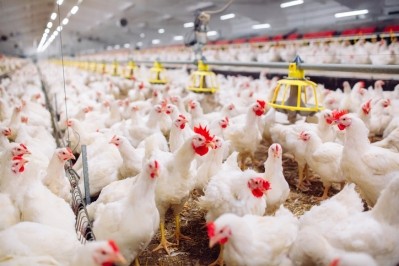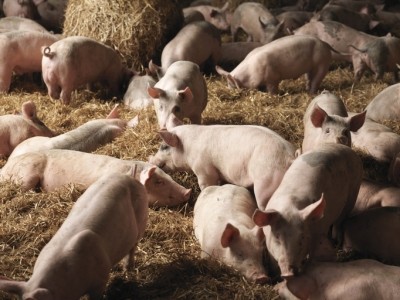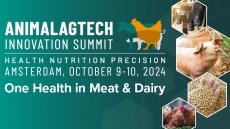New study first to show probiotics and postbiotics boost vaccine efficacy in chickens

Probiotics and postbiotics, specifically, have demonstrated potential to combat antimicrobial resistance (AMR), according to Victor Nsereko, research lead for the TRANSFORM project.
Cargill, as part of its leadership in that USAID-funded project aimed at combatting the escalating threat of AMR, partnered with West Bengal University of Animal and Fishery Sciences on a trial with broiler chickens. The study, which was published in the journal Animals, revealed improvements in growth performance, vaccine efficacy, and pathogen reduction through specific animal nutrition interventions.
The study assessed the effects of Bacillus subtilis (a probiotic) and Saccharomyces cerevisiae fermentation product (SCFP, a postbiotic).
“The SCFP (Diamond V Original XPC) was chosen for this study due to its well-documented benefits on the health and performance of chickens. The probiotic Bacillus subtilis was selected as it is readily available in India and has also been shown to improve broiler health and performance. Both products have a long history of safe use and multiple established functionalities, as supported by peer-reviewed scientific literature. Our goal was to identify and evaluate commercially available products that could enhance poultry health and performance by bolstering immune function,” explained Nsereko.
The trial was conducted in a biosecure facility with standard vaccinations and nutritionally balanced diets, and the inclusion rates used were recommended by the manufacturers of both products
Notably, the researchers maintain that theirs is the first study to show a positive effect of such an animal nutrition strategy on the efficacy of the infectious bursal disease vaccine in broilers.
Key findings
The main findings of the research included:
Improved growth performance: The team saw that SCFP enhanced feed conversion efficiency (FCR), allowing broilers to gain similar weight with less feed. Both interventions also increased the villi height-to-crypt-depth ratio (VH), improving the intestinal surface area available for nutrient absorption.
Enhanced vaccine efficacy: The researchers also saw that SCFP boosted antibody titers, improving immune response to vaccinations against Newcastle disease and infectious bursal disease. This suggested improved vaccine protection in treated broilers, they reported.
Pathogen reduction: SCFP significantly reduced antimicrobial-resistant bacteria, such as ESBL-producing Enterobacteriaceae and Salmonella species.
“One of the key findings was a significant reduction in pre-cecal antimicrobial-resistant pathogens, specifically ESBL-producing Enterobacteriaceae, in the treatment groups compared to the control group. While Bacillus subtilis had previously been shown to reduce ESBL-producing E. coli in vitro, the in vivo results observed in this study are novel. Additionally, there are no prior reports on the effect of SCFP on ESBL-producing Enterobacteriaceae, making this another new and noteworthy discovery from the study,” Nsersko told us.
Stress reduction
The results also showed improvements in gut morphology and reductions in stress-related hormones (corticosterone) and cholesterol levels in birds treated with SCFP.
“Stress triggers the hypothalamus-pituitary-adrenal (HPA) axis, increasing plasma corticosterone levels in chickens. The antioxidants in SCFP may inhibit corticosterone synthesis, helping to lower stress levels.
“The reduction in corticosterone levels due to SCFP has been documented previously. Broilers fed SCFP have shown improved performance under stress, such as heat stress, likely due to its positive impact on immunity. Elevated corticosterone levels are known to suppress humoral immunity and reduce antibody production. In our study, lower corticosterone levels in SCFP-fed birds were associated with enhanced humoral immunity, as demonstrated by increased antibody titers against Newcastle Disease Virus and Infectious Bursal Disease Virus.
“While the mechanism behind the reduced serum cholesterol levels in SCFP-fed birds is not fully understood, the likely explanation for the lower cholesterol in SCFP-treated birds is the alteration of gut microbes, leading to enhanced bile salt deconjugation and excretion. This signals the host to use more cholesterol for synthesizing new bile salts,” commented Nsereko.
Enhanced growth
Explaining the significance of the increase in villi height and the villi-height-to-crypt-depth ratio (VH) in broilers and how this impacts overall gut health and nutrient absorption, he remarked:
“An increase in villus height expands the intestinal surface area available for nutrient absorption, allowing for more efficient uptake of nutrients. A shallower crypt depth, on the other hand, indicates faster tissue regeneration, as the crypts produce new villi to meet the demand for tissue growth.
“In our study, birds supplemented with SCFP showed a significant increase in villi height in the duodenum, jejunum, and ileum compared to the control group, confirming previous findings. Additionally, the villi height-to-crypt depth ratio was significantly higher in the ileum of the SCFP-fed group. This aligns with reports that Saccharomyces cerevisiae exerts a trophic effect on the villi in the ileum and jejunum, more so than in the duodenum, as observed in our study. Since the ileum is the primary site for amino acid absorption, longer villi in this region suggest improved nutrient utilization, which likely contributes to enhanced growth performance.”
Data relevant to local conditions is key
As to whether there are potential limitations to the broader application of SCFP and probiotics in commercial poultry farming, such as cost, availability, or variability in efficacy across different breeds or environmental conditions, he said:
“SCFP and probiotics are broad categories of products, but their effectiveness depends on selecting individual products with proven benefits tailored to specific application scenarios. It is essential to have data relevant to local conditions, including appropriate breeds, feed formulations, and production environments, to demonstrate the product's utility and return on investment (ROI).
“Non-sporulating probiotics are particularly vulnerable to environmental and feed production conditions, which can compromise their effectiveness, making them less suitable in some situations. Since probiotics consist of live microorganisms, maintaining their viability during feed production, storage, and feeding poses significant challenges. In contrast, SCFP products are more stable and retain their efficacy even under the harsh conditions of feed manufacturing and processing.
“However, the cost of both probiotics and SCFP can be a limiting factor in many regions. For these products to be adopted commercially, they must demonstrate a clear ROI, such as reducing production costs, improving feed conversion ratios, or increasing overall productivity.”
Boosting resilience
SCFP and probiotics hold potential for improving poultry performance and enhancing resilience against stress-related challenges, said the researcher.
“By supporting gut health and immune function, SCFP can serve as an essential nutritional tool when combined with proper farm management and biosecurity measures. This comprehensive approach promotes overall poultry health and reduces the need for antibiotics.”
However, once infections are established, antibiotics or other treatments will be required for effective disease management, he added.
Future research
Nsereko highlighted that more research is needed to fully understand the mechanisms behind the effects of SCFP and probiotics on poultry health and performance. He also suggested that future studies should focus on pre-harvest microbial safety and the potential to introduce more effective products that could further reduce pathogens harmful to both animals and humans.
Through the TRANSFORM project, Cargill aims to continue exploring how animal nutrition can play a critical role in addressing challenges related to pathogen control and antimicrobial resistance over the next two years. Those behind the initiative plan to complete nearly two dozen research trials across four species by 2026.
Source: Animals
Title: Efficacy of Saccharomyces cerevisiae Fermentation Product and Probiotic Supplementation on Growth Performance, Gut Microflora and Immunity of Broiler Chickens
Authors: Soren et al
















